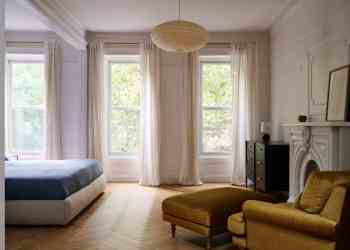The Dirty Business of Fireplace Renovation
A reader who’s in the midst of a project to convert two of the fireplaces in his Clinton Hill brownstone to wood-burning and reline three of his flues sends in a mid-project report. So far everything’s going well, if a little slow: So far, the workers have been very careful to protect the existing mantels…


A reader who’s in the midst of a project to convert two of the fireplaces in his Clinton Hill brownstone to wood-burning and reline three of his flues sends in a mid-project report. So far everything’s going well, if a little slow: So far, the workers have been very careful to protect the existing mantels and surrounding parquet floors with rosin paper. We can imagine that having to witness holes getting punched in the walls might be a little traumatic, but since the flues aren’t straight, it’s the only way to go in this case. Getting down to the boiler from the ground-floor kitchen has proven to be the trickiest part of the job so far because the original hearth in the kitchen, which serves as the foundation for the three fireplaces above it, gets very narrow in places. Ultimately, the workmen were able to get the piping through it though. When the job’s complete, we’ll have a final report. In the meantime, check out the slideshow on the link. Update: The slideshow should be working now.
Fireplace Reno Slideshow [Flickr]









I would like to get the original gas fireplaces in my 1899 brownstone working again. Halstead W wants $10K per fireplace to rebuild the firebox and flue. Since I want to stay with gas, rather than wood, is there a less expensive way than the complete rebuild? Is it possible to just put a metal tube insert in the flue, maybe with a draft inducer? Or is it really necessary to pull the mantles off, open up the wall and rebuild everything?
I have been thinking about doing the same thing with the gas fireplace in our brownstone. I am really torn between gas and wood. We still have the original gas heater that was installed, and it’s in great shape, although it’s not currently hooked up – but do I really want to be burning fossil fuels? The smell and the sound of wood is great, but then there’s the air pollution aspect… plus the prospect of tearing out the mantel, tearing out the walls, and maybe freaking out my neighbors is making me nervous. But its good to see someone who took the plunge and was happy with the results.
Just checking back in to see if people want to talk about this sort of project. Thanks, Guest 6:36 for some really interesting history. I think your point, below, is well-taken:
“I think experts might advise against burning wood in a fireplace and chimney meant for a gas porcelain stove.”
…. unless you re-line your chimney with stainless steel, as we did. Clearly that makes it perfectly safe.
Now if this damned 80-degree weather would just go away!!!
Sorry Rehab–just saw you had the name and phone number listed–disregard the request.
Rehab,
Lookin’ Good! Now that you seem pleased, will you post the name/contact info of the chimney guys?
Bob,
Reading the comments above, I see you mentioned gas was preferred over wood. I think wood was something that was not burned in excess in Brownstone Brooklyn. COAL was King, the first BIG fossil fuel that “made” the 1800’s happen and helped make Brownstone Brooklyn possible. We often don’t realize that the areas around East Coast cities were heavily deforested quite early on and especially by the time the late 1800’s rolled around. [Side note: Boston was having problems securing enough wood for fuel in the 1700’s]. Vast areas were being farmed and grazed. I’ve heard that in many places the NE is more forested today than it was in 1875. Coal heated the rooms in coal-burning fireplaces. Coal cooked food in the kitchen and eventually was eventually used for stand-alone furnaces that heated house and water. Our house (1856) had no basement boiler. Coal burners in each room served to heat rooms as needed and a coal stove heated water and cooked food in the kitchen.
The firebrick fireplaces we now see often had a porcelain gas-burner which, yes, as you point out were retrofitted into older homes and build into new homes as part of colonial revival style. Colonial revival started in the late 1800’s when coal was still much cheaper (and convenient) for heating. Eventually, by the 19teens gas-burning heaters were being put into these firebrick-lined fireplaces. I think experts might advise against burning wood in a fireplace and chimney meant for a gas porcelain stove. Worse yet, would be burning wood in the shallow fireplaces that once had coal baskets in them.
[Coal still *is* King, BTW. We tend to forget in NYC that much of US electrical generation is coal-based.]
I wonder high many feet the flue runs? We have a problem in our fireplaces — getting the draft going upward. Once we open the flue in cold weather, the cold air streams down it. The draft needs to be reversed before the fire really gets going, otherwise the house fills with smoke. We light newspaper, trying to heat the air and reverse the draft — but it doesn’t generate enough heat given the 4 floors to roof. At the suggestion of the fireplace people, we started using a hair blower! Awkward but effective. We also have those twirly hats on the top of the flues to minimize downdraft. Once I read about fans that fit on the top of the flue, but they cost about $1,000 plus the electrician. Once the fire dies down, the draft changes and we get the nasty smell of charred wood in our house. Anyone else have this problem and how did they deal with uit? Thanks.
That looks great!
Can you tell me the dimension of your new fireplace? How deep/wide is it? Is it really just for burning kindling or can i put a fire that is decent enough to provide a little heat?
Thanks!
I’m wondering whether any of you know an independent chimney inspector who could advise me on whether I really need to reline my chimney before opening and reactivating my fireplace (Victorian Flatbush)?
I can’t wrap my brain around the idea of having some outfit that also does the work–and, thus, might have a vested interest in telling me that I do need to reline–perform the inspection.
I’d rather pay someone with no horse in the race to do it.
A gravity hot air furnace (which, I think, is the correct term) is one without a fan that depends on hot air being lighter than cold and rising through heating ducts. The one in my house was replaced (according to the previous owner) by a more efficent forced hot air furnace (which uses a blower fan) around 1965. The original must have been an enormous coal-fired contraption, with octapus arm-like ducts covering most of my cellar 9the replacement duct work is far more compact). It was probably converted to gas long before it was replaced. I’m sure a few brownstones still use these original furnaces.